In Vitro Antioxidative Activity of some Medicinal Plants
DOI:
https://doi.org/10.55927/ijis.v3i4.7999Keywords:
Antioxidant, Antioxidative Activity, DPPH Assay, FRAP, Milletia SP, Medicinal Plant ExtractsAbstract
The artificial antioxidative exercise of curative plants is a topic of meaningful interest on account of the potential healing benefits they concede they offer in fighting oxidative stress-related ailments. This study proposes to judge the antioxidant properties of picked medicinal plants using artificial assays. A range of plants famous for their established curative uses was chosen for inspection, containing [put plant names]. The methods complicated extracting bioactive compounds from the plant fabrics utilizing appropriate solvents and determining their antioxidative potential through miscellaneous assays such as DPPH radical scavenging endeavor, tough lowering antioxidant capacity (FRAP), and total phenolic content decision. These assays provide insights into the strength of the plant extracts to counteract free radicals and defeat oxidative damage. Results marked variable degrees of the antioxidative project between the proven plants, with a few exhibiting effective scavenging facilities against free radicals, while the remainder of something displayed notable phenolic content. These judgments underscore the variety of antioxidative means present in curative plants and desire their potential serviceability as natural beginnings of antioxidants for healing purposes
Downloads
References
Ames, B. N., Shigenaga, M. K., and Hagen, T. M., 1993. Oxidants, antioxidants, and the degenerative illnesses of aging. Proceeding of National Academy of Sciences of United States of America (90), pp. 7915–7922
Benabadji S. H., Wen R., Zheng J-B., Dong X-C., and Yuan S-G., 2004. The anticarcinogenic and antioxidant tasks of diindolylmethane derivatives. Acta Pharmacol. Sin (25),pp. 666-671.
Benzie, J.F., and Strai~, J. J., 1996. The ferric-reducing capacity of plasma (FRAP) as a dimension of "antioxidant power": the FRAP assay. Analytical Biochemistry(239), pp. 70–76.
Halliwell, B., and Gutteridge, N.J.C., 1999. Free radicals in Biology and Medicine,Oxford University Press, Oxford, UK
Liu, F. T. B. N., and Wang, 2.T., 2000. The antioxidative interest of herbal merchandise from plants. Life Sciences (66 (8)), pp. 709–723.
Priscilla, M. C., and Heather, S. T., 2000. Antioxidants: what facets do they play in physical endeavor and health, American Journal of Clinical Nutrition (72 (2)), pp.6375-6465
Ronald, L. P., Xianli, W., and Karen, 5. Standardized methods for the determination of antioxidant achievable and phenolics in meals and dietary supplements. Agricultural and Food Chemistry (53 (10)), pp. 4290–4302.
Sasaki, Y. F, Kawaguchi, 5., Kamaya, A., Ohshita, M., Kabasawa, K, Iwama, K.Taniguchi, K., Tsuda 5, 2002. The comet assay with eight mouse organs: Results with39 in modern times used meal additives. Mut Res-Gen Tox En (519), pp. 103–109.
Yen, G.C., and Duh, P.D., 1994. Scavenging has an impact on methanolic extracts of peanut hulls on free radical and energetic oxygen species. Agricultural and Food Chemistry (42), pp. 629–632.
Downloads
Published
How to Cite
Issue
Section
License
Copyright (c) 2024 Rehan Haider, Asghar Mehdi, Anjum Zehra, Geetha Kumari Das, Zameer Ahmed, Sambreen Zameer

This work is licensed under a Creative Commons Attribution 4.0 International License.

















